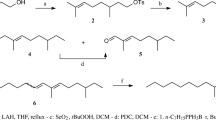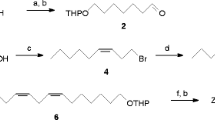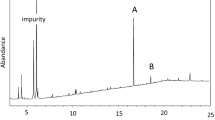Abstract
Extracts obtained by rinsing the thorax and extracts from the tergal sex pheromone gland of females of the bagworm moth, Megalophanes viciella, as well as headspace samples from live animals, were analyzed to reveal the chemical structure of the pheromone. As a result, 1-methylethyl octanoate was established as a main sex pheromone component of this species. This was further confirmed by numerous catches of conspecific males in traps baited with this compound in Bulgaria and Roumania.
Similar content being viewed by others
REFERENCES
Arn, H., Toth, M., and Priesner, E. 1992. List of Sex Pheromones of Lepidoptera and Related Attractants, 2nd ed. OILB SROP Publ., Paris, 179 pp.
Dettner, K. 1984. Isopropylesters as wetting agents from the defensive secretion of the rove beetle Coprophilus striatulus F. Insect Biochem. 14:383–390.
Dierl, W. 1973. Hypodermale Drüsenfelder in Thorax und Abdomen apterer Psychidae-Weibchen. Opusc. Zool. 127:1–8.
Dierl, W. 1979. Taktile Reize als Auslöser im Paarungsverhalten von Psychiden (Lepidoptera, Psychidae). Spixiana 2:59–62.
Francke, W., Levinson, A. R., Jen, T.-L., and Levinson, H. Z. 1979. 2-Propyl carboxylates—a new class of insect pheromones. Angew. Chem. Int. Ed. Engl. 18:796–797.
Francke, W., Toth, M., SzÖcs, G., Krieg, W., Ernst, H., and Buschmann, E. 1988. Identifizierung und Synthese von Dimethylalkanen als Sexuallockstoffe weiblicher Miniermotten (Lyonetiidae). Z. Naturforsch. 43c:787–789.
Hallberg, E., and Subchev, M. 1997. Unusual location and structure of female pheromone gland in Ino ampelophaga Bayle (Lepidoptera: Zygaenidae). Int. J. Insect Morphol. Embryol. 25:381–389.
Klimetzek, D., KÖhler, J., Krohn, S., and Francke, W. 1989. Das Pheromon-System des Waldreben-Borkenkäfers, Xylocleptes bispinus Duft. (Col., Scolitydae). J. Appl. Entomol. 107:304–309.
Kozhanchikov, I. V. 1956. Fauna of the USSR. Lepidopteran Insects, Vol. III. Psychid moths (fam. Psychidae). Moscow Academia of Sciences of the USSR. pp. 516 (in Russian), p. 2.
Kozlov, M. V., Zhu, J., Phillipp, P., Francke, W., Zvereva, E. L., Hansson, B. S., and LÖfstedt, C. 1996. Pheromone specificity in Eriocrania semipurpurella (Stephens) and E. sangii (Wood) (Lepidoptera: Eriocranidae) based on chirality of semiochemicals. J. Chem. Ecol. 22:431–434.
Leonhardt, B. A., Neal, J. W., Jr., Klun, J. A., Schwarz, M., and Plimmer, J. R. 1983. An unusual lepidopteran sex pheromone system in the bagworm. Science 219:314–316.
LÖfstedt, C., and Kozlov, M. 1997. Phylogenetic analysis of pheromone communication in primitive moths, pp. 473-489, in R. T. Cardé and A. K. Minks (eds.). Insect Pheromone Research. Chapman & Hall, New York.
McLafferty, F. W., and Stauffer, D. B. 1988. The Wiley/NBS Registry of Mass Spectral Data. Vol. 1. John Wiley & Sons, New York.
Myerson, J., Haddon, W. F., and Soderstrom, E. L. 1982. sec-Butyl (Z)-7-tetradecenoate. A novel sex pheromone component from the western grapeleaf skeletonizer, Harrisina brillians. Tetrahedron Lett. 23:2757–2760.
Peschke, K., Friedrich, P., Kaiser, U., Franke, S., and Francke, W. 1999. Isopropyl (Z9)-hexadecenoate as a male attractant pheromone from the sternal gland of the rove beetle Aleochara curtula (Coleoptera: Staphylinidae) Chemoecology 9:47–54.
Priesner, E., Naumann, C. M., and Stertenbrink, J. 1984. Specificity of synthetic sex attractants in Zygaena moths. Z. Naturforsch 39c:841–844.
Rhainds, M., Gries, G., Li, J., Gries, R., Slessor, K. N., Chinchilla, C. M., and Oehlschlager, A. C. 1994. Chiral esters: Sex pheromone of the bagworm, Oiketikus kirbyi (Lepidoptera: Psychidae). J. Chem. Ecol. 20:3083–3096.
SUBCHEV, M., Harizanov, A., Francke, W., Franke, S., Plass, E., Reckziegel, A., SchrÖder, F., Pickett, J. A., Wadhams, L. J., and Woodcock, C. M. 1998. The sex pheromone of the female vine bud moth, Theresimima ampellophaga Bayle-Barelle (Lepidoptera: Zygaenidae), comprises (2S)-butyl (7Z)-tetradecenoate. J. Chem. Ecol. 24:1141-1151. See also Erratum: J. Chem. Ecol. 25:1203 (1999).
TengÖ, J., Groth, I., BergstrÖm, G., SchrÖder, W., Krohn, S., and Francke, W. 1985. Volatile secretions in three species of Dufourea (Hymenoptera: Halictidae) bees: Chemical composition and phylogeny. Z. Naturforsch. 40c:657–660.
Warthen, J. D., Klun, J. A., and Devilbiss, E. D. 1996. Structure-activity, relationship observations for the bagworm moth pheromone. J. Chem. Ecol. 22:1315–1324.
Zagatti, P., and Renou, M. 1984. Les pheromones sexuelles des zygenes. Le comportement de Zygaena filipendulae L. (Lepiodoptera, Zygaenidae). Ann. Soc. Entomol. Fr. 20:439–454.
Zhu, J., Kozlov, M. V., Philipp, P., Francke, W., and LÖfstedt, C. 1995. Identification of a novel moth sex pheromone in Eriocrania cicatricella (Zett.) (Lepidoptera: Eriocranidae) and its phylogenetic implications. J. Chem. Ecol. 21:29–43.
Author information
Authors and Affiliations
Rights and permissions
About this article
Cite this article
Subchev, M., Toshova, T., Stanimirova, L. et al. 1-Methylethyl Octanoate, a New Lepidopteran Sex Pheromone from the Bagworm, Megalophanes viciella. J Chem Ecol 26, 487–495 (2000). https://doi.org/10.1023/A:1005421808497
Issue Date:
DOI: https://doi.org/10.1023/A:1005421808497




